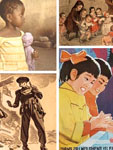What Every American Needs to Know About Iran
Patrick Clawson, Deputy Director of Research at the Washington Institute for Near East Policy, looks at Iran's development of nuclear weapons.
Audio and video options are available.
Patrick Clawson, Deputy Director of Research at the Washington Institute for Near East Policy, looks at Iran's development of nuclear weapons.
Audio and video options are available.
Harvey Sicherman, President of the Foreign Policy Research Institute, looks at the current war in Iraq; and asks what relationship it has with the War on Terrorism. He outlines previous presidential stands on terrorism, which largely ideologically opposed terrorism, but did not take direct, open action against it—contrasting them with Bush's active declaration of war against terrorism. Sicherman argues that the war in Iraq functions as an extension of the war on terrorism and of previous U.S. policy in the Middle East.
Video and audio options are available.
David Eisenhower of the Foreign Policy Research Institute considers the current necessity of approaching terrorism and the current war as teaching subjects, and looks at how national crises—such as 9/11—pose certain rhetorical and leadership demands on presidents, and how President Bush reacted to these demands.
Video and audio options are available.
Paul Dickler of Neshaminy High School reviews several points he considers important in teaching on 9/11 and terrorism, as well as in teaching history more generally.
Audio and video options are available.
Michael Radu and Stephen Gale, co-chairs of the Foreign Policy Research Institute's Center on Terrorism, Counter-Terrorism, and Homeland Security, present the FPRI's annual report on the current state of the War on Terrorism.
Norman Ornstein discusses the changing U.S national political atmosphere following the 9/11 attacks and his opinions on these changes, as well as speaking briefly on his career as a political writer.
To listen to this interview, scroll to "Norman Ornstein" and select "Watch the Video."

The Central Intelligence Agency (CIA) has digitized thousands of formerly secret documents declassified to comply with Freedom of Information Act requests.
Keyword search capabilities are provided for the complete site. In addition, there are eight collections designated as "frequently requested records" that total nearly 8,000 documents. These collections cover a number of Cold War topics: CIA involvement in the 1954 coup in Guatemala; convicted spies Ethel and Julius Rosenberg; the 1961 Bay of Pigs affair; and two well-known espionage incidents.
Additional topics include POW MIAs in Vietnam, human rights abuses in Latin America, and UFOs. A disclaimer notes that some material cannot be disclosed due to national security laws, and released pages often have material deleted or blacked out. Still, the material offered is voluminous and useful for studying Cold War foreign policy and military history.
On this electronic field trip, students get the chance to see up close historical documents such as the Declaration of Independence and the U.S. Constitution. Students will also have entry to the entire Independence National Historical Park with 21 historical sites available for fascinating tours.
Samantha Hunt, author of the historical fiction novel The Invention of Everything Else, written from the perspective of inventor Nikola Tesla, reads an excerpt from her novel and briefly talks about the inventor's life and personality.

This website presents historical sources and teaching materials that address notions of childhood and the experiences of children and youth throughout history and around the world. Primary sources can be found in a database of 200 annotated primary sources, including objects, photographs and paintings, quantitative evidence, and texts, as well as through 50 website reviews covering all regions of the world. More than 20 reviews and more than 70 primary sources relate to North American history.
The website also includes 20 teaching case studies written by experienced educators that model strategies for using primary sources to teach the history of childhood and youth, as well as 10 teaching modules that provide historical context, strategies for teaching with sets of roughly 10 primary sources, and a lesson plan and document-based question. These teaching resources cover topics ranging from the transatlantic slave trade, to girlhood as portrayed in the novel Little Women, to children and human rights. Eight case studies relate to North American history, as do two teaching modules.
The website also includes a useful introductory essay outlining major themes in the history of childhood and youth and addressing the use of primary sources for understanding this history.